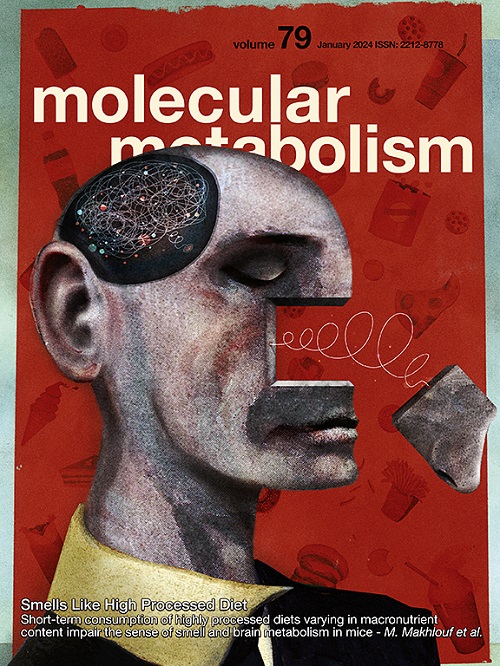aregs - igfbp3介导的smc样细胞凋亡损害老年小鼠米色脂肪细胞的形成。
IF 7
2区 医学
Q1 ENDOCRINOLOGY & METABOLISM
引用次数: 0
摘要
衰老与白色脂肪组织(WAT)褐变能力下降有关,从而导致代谢功能障碍。米色脂肪细胞以热量形式耗散多余能量,是这一过程的关键特征。在本研究中,我们研究了脂肪干细胞和祖细胞(ASPCs),特别是Aregs(CD142+)亚群在冷刺激下调节老年小鼠米色脂肪细胞形成的作用。我们的研究结果表明,寒冷暴露后,Aregs 在老龄小鼠皮下 WAT(sWAT)中明显增加。我们进一步证明,Aregs能分泌胰岛素样生长因子结合蛋白3(IGFBP3),它似乎在脂肪生成调节细胞(Aregs)和平滑肌样细胞(SMC样细胞)之间的交叉对话中起着关键作用,从而导致对米色脂肪细胞形成的抑制。功能富集分析显示,SMC样细胞中的TGFβ、MAPK和p53信号通路被激活,而所有这些通路都可诱导细胞凋亡和纤维化。此外,研究还发现 IGFBP3 能与 SMC 样细胞中的 Egfr、Irf1 和 Cdkn1a 等受体和信号分子相互作用,从而增强细胞凋亡。共培养实验证实,IGFBP3 能显著抑制米色脂肪细胞的形成,进一步证实了它在褐变过程中的作用。总之,我们的研究为了解 Aregs 和 IGFBP3 促成与年龄相关的 WAT 褐化下降的分子机制提供了新的见解。这些发现为逆转衰老和相关代谢疾病中受损的脂肪细胞褐变提供了潜在的治疗靶点。本文章由计算机程序翻译,如有差异,请以英文原文为准。

Aregs-IGFBP3-mediated SMC-like cells apoptosis impairs beige adipocytes formation in aged mice
Aging is associated with a decline in the browning capacity of white adipose tissue (WAT), contributing to metabolic dysfunction. Beige adipocytes, which dissipate excess energy as heat, are a key feature of this process. In this study, we investigate the role of adipose stem and progenitor cells (ASPCs), specifically the Aregs (CD142+) subpopulation, in regulating beige adipocyte formation in aged mice under cold stimulation. Our findings reveal that Aregs significantly increase in the subcutaneous WAT (sWAT) of aged mice following cold exposure. We further demonstrate that Aregs secrete insulin-like growth factor binding protein 3 (IGFBP3), which appears to play a pivotal role in the cross-talk between adipogenesis-regulatory cells (Aregs) and smooth muscle cell-like (SMC-like) cells, thereby leading to the inhibition of beige adipocytes formation. Functional enrichment analysis highlighted the activation of TGFβ, MAPK and p53 signaling pathways in SMC-like cells, all of which are known to induce cell apoptosis and fibrosis. Moreover, IGFBP3 was found to interact with receptors and signaling molecules, including Egfr, Irf1 and Cdkn1a, in SMC-like cells, enhancing their apoptosis. Co-culture experiments confirmed that IGFBP3 significantly suppressed the formation of beige adipocytes, further corroborating its role in impairing browning. Overall, our study provides novel insights into the molecular mechanisms by which Aregs and IGFBP3 contribute to the age-related decline in WAT browning. These findings suggest potential therapeutic targets for reversing impaired WAT browning in aging and related metabolic disorders.
求助全文
通过发布文献求助,成功后即可免费获取论文全文。
去求助
来源期刊

Molecular Metabolism
ENDOCRINOLOGY & METABOLISM-
CiteScore
14.50
自引率
2.50%
发文量
219
审稿时长
43 days
期刊介绍:
Molecular Metabolism is a leading journal dedicated to sharing groundbreaking discoveries in the field of energy homeostasis and the underlying factors of metabolic disorders. These disorders include obesity, diabetes, cardiovascular disease, and cancer. Our journal focuses on publishing research driven by hypotheses and conducted to the highest standards, aiming to provide a mechanistic understanding of energy homeostasis-related behavior, physiology, and dysfunction.
We promote interdisciplinary science, covering a broad range of approaches from molecules to humans throughout the lifespan. Our goal is to contribute to transformative research in metabolism, which has the potential to revolutionize the field. By enabling progress in the prognosis, prevention, and ultimately the cure of metabolic disorders and their long-term complications, our journal seeks to better the future of health and well-being.
 求助内容:
求助内容: 应助结果提醒方式:
应助结果提醒方式:


